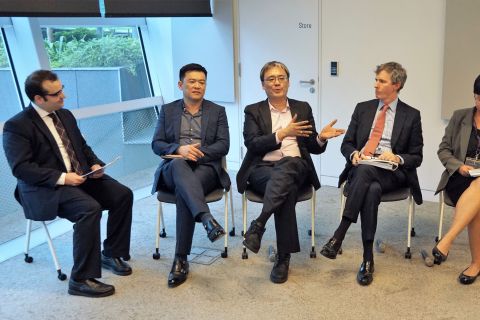
By Jeremy Chan
SMU Office of Research & Tech Transfer – Between the carrot and the stick – reward and reprisal – lie rules that encourage certain behaviours while suppressing others. Every level of human society, be it small communities, large corporations or entire countries, operates on rules (sometimes called laws) that keep things orderly and functioning.
Yet, these regulations can sometimes have unintended consequences or questionable efficacy, highlighting the need to periodically assess, review and change them where necessary. This is where academics like Assistant Professor Zhang Wei at the Singapore Management University (SMU) School of Law can play an important role in understanding the nuances of corporate governance measures and legal systems, potentially improving those systems for the better.
“I am interested in using statistical, quantitative empirical methods to study Chinese law and corporate governance,” says Prof Zhang. “The behaviours of organisations under certain requirements or restrictions can be very intriguing.”
Playing the numbers game
In the domain of Chinese law, Prof Zhang notes that the post-Mao era of governance in China has seen the proliferation of mathematical methods to measure the performance of organisations. These ‘rules’ extend even to the judicial system.
An interesting case study arises in Shanghai, where judges are assessed with the Shanghai Court Adjudication Quality and Efficiency Composite Index, which comprises 24 components grouped under three sub-indices – ‘effect’, ‘efficiency’ and ‘justice’. Of all these components, two are of special interest and most heavily weighted: the rate of mediation and withdrawal (RMW), which essentially measures the rate of settlements after filing; and the rate of closure without appeal (RWA), which captures the rate of case closure without further appeals. Therefore, judges with a higher RMW or a lower RWA are deemed as better at dispensing their adjudicative duties.
Although the use of numerical criteria may seem like an attractive and objective approach to managing judges, Prof Zhang’s research has revealed that the reliance on such clear-cut performance indicators has resulted in some courts “gaming the system” when it comes to judging cases of medical malpractice. “I found that judges may attempt to manipulate the court decisions on two aspects – compensation awards and the allocation of litigation costs,” he says.
For example, Prof Zhang observed that an increase in RMW by one percentage point in the prior year was associated with a 20 percent increase in the average amount of compensation awarded in the current year. This hints at a propensity to promote settlements to further boost one’s RMW. Also, the plaintiff’s share of litigation costs would decrease by approximately six percentage points as RMW rises by one percentage point in the previous year, suggesting that the court may assign the greater burden of litigation costs to the defendant to avoid complaints by the plaintiff.
“The evidence shows that yes, there is some gaming of the system, but there are counteracting forces in the judicial system that prevent it from getting out of hand,” Prof Zhang explains. His findings are reported in a paper titled ‘Managing judges mathematically: an empirical study of the medical malpractice litigations in Shanghai’, published in Constitutional Political Economy in 2017.
Keeping companies on the straight and narrow
More recently, Prof Zhang has turned his attention to the inner workings of corporations in Asia, focusing on board composition. Boards in companies are meant to ensure that managers act in the interests of the company and its shareholders. A corollary of this argument entails having independent board members who can exercise objective judgement on how companies are being run.
Prof Zhang and his co-authors wanted to find out whether having a larger proportion of independent board members necessarily translates to a reduction in related-party transactions (RPTs) – a scenario where managers benefit at the expense of the company, thereby undermining firm value. Choosing Singapore and Hong Kong for their similar corporate governance frameworks derived from British rule and their reputation as two of Asia’s prominent financial centres, they noted that higher board independence was correlated with fewer and lower-volume RPTs.
“However, when we looked at causality – whether the reduction in RPTs is actually caused by the increase in the number of independent directors – we did not find very strong evidence,” says Prof Zhang, adding that the marginal benefits of further increasing the proportion of independent board members is limited. Therefore, improving board composition should not be the only strategy to deter RPTs in companies. Prof Zhang published these findings in an article titled ‘Board independence as a panacea to tunneling? An empirical study of related party transactions in Hong Kong and Singapore’ in the Journal of Empirical Legal Studies in 2018.
A focus on Asia
Tangential to his interests in Chinese and corporate law, Prof Zhang has also looked into the interaction between listing rules and mergers and acquisition rules in China.
“The listing status of companies in China is very precious because there is a very significant entry barrier. But under certain conditions, if a bidder wants to take control of a listed company, there is a risk of the target company becoming de-listed,” he says. “So we want to examine the strategies bidders may be using to ‘have their cake and eat it’.”
Another line of inquiry has to do with dual class stocks, wherein a company issues various classes of shares to the general public and its executives, differentiated by voting rights. Such share structures are common in American companies but only beginning to be adopted by enterprises in Asia, which makes it an interesting emerging field of study, says Prof Zhang.
“As with any scientific study, my goal is to not only describe the observations, but also to find explanations and plot out reasons why they occur,” he emphasises. “The results of my research could help inform the design of policies that influence innovation, corporate value and economic development.”
Back to Research@SMU May 2019 Issue
See More News
Want to see more of SMU Research?
Sign up for Research@SMU e-newslettter to know more about our research and research-related events!
If you would like to remove yourself from all our mailing list, please visit https://eservices.smu.edu.sg/internet/DNC/Default.aspx

